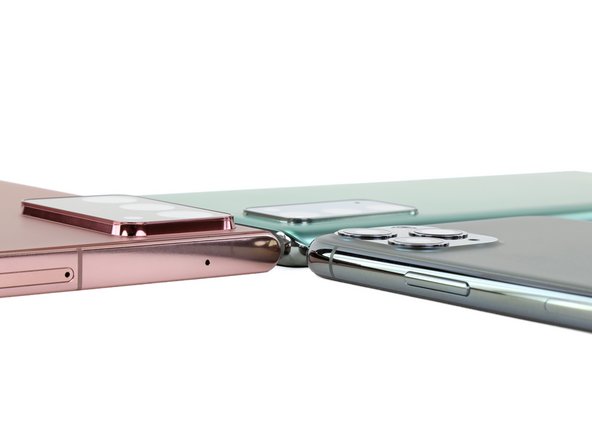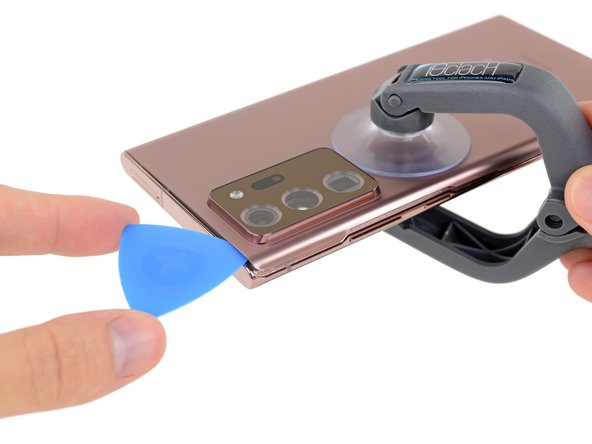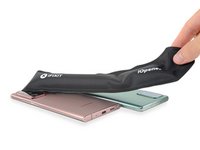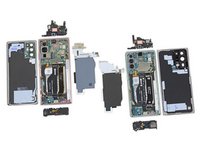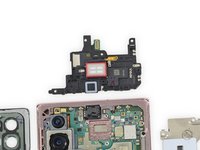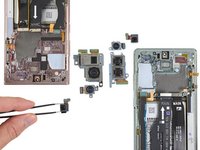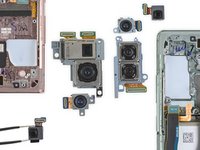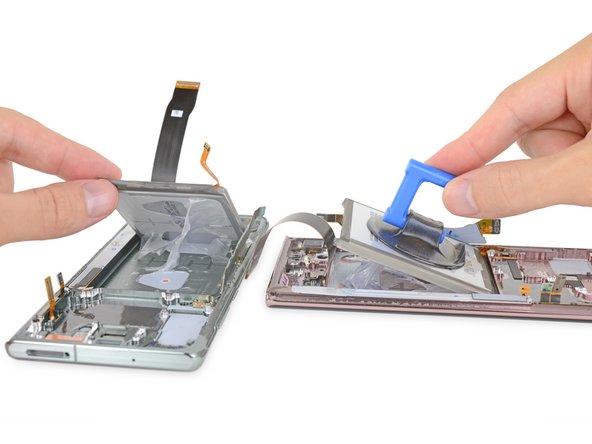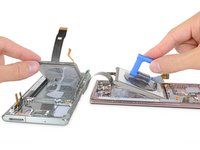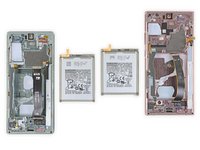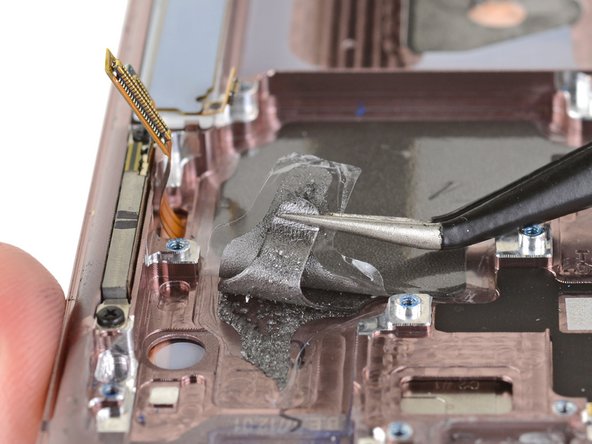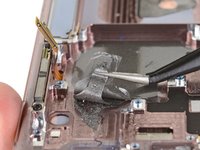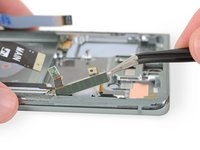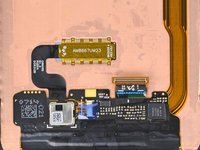简介
We’re on a mission to tear down all the Galaxy Things that Samsung released at Unpacked this month. Beans? All chewed up. Watch? All wound down. Next on the teardown table: the Galaxy Note 20 and 20 Ultra. It’s a side-by-side teardown-athon that we won’t be doing twice, so grab your S-Pen and follow along as we scribble out these Notes.
For more teardowns than you can swing a stylus at, follow us on Twitter, Instagram, and Facebook. For iFixit delivered, check out our newsletter.
你所需要的
视频概述
-
-
There are multiple versions of both these phones in circulation—but we opted for US models with 5G mmWave to bring you the most complete-est teardown for your money. Our specs include:
-
Snapdragon 865+ processors paired with 8 GB (Note 20) or 12 GB (Ultra) of LPDDR5
-
Infinity-O AMOLED displays—6.7" (2400 × 1080) on the Note 20, and 6.9" (3088 × 1440) on the Ultra with 120 Hz refresh rate
-
128 GB of internal storage, plus up to an extra 1 TB on the Ultra via microSD
-
Four cameras each, including a 10 MP selfie and 12 MP ultra-wide. The vanilla Note 20 also gets a 12 MP wide-angle and a 64 MP telephoto, while the Ultra packs a 108 MP wide-angle and a 12 MP periscope telephoto with 5x optical zoom
-
Batteries: 4300 mAh in the Note 20, and 4500 mAh in the Ultra
-
5G and Ultra Wide Band connectivity, plus 4x4 MIMO LTE, 802.11ax Wi-Fi, and BT 5.0
-
-
-
One important spec we left out: colors! We opted for Mystic Green on the Note 20, and Mystic Bronze on the Ultra. Why? Because there was no Mystic Blue and Black option.
-
For instance, why are the wireless charging coils—those concentric rings in the middle of each phone—so different? Samsung hasn't hinted at any major spec differences, but the Ultra has an intriguing double-coil configuration.
-
It's also striking how much extra real estate the Ultra devotes to its camera modules. That 108 MP peeper in the middle is already enormous, and that's before Samsung throws in the sliding periscope module right next to it.
-
-
-
First things first, we use our S Pens to jot down a few notes about camera bumps. If you like your glass to have glass sticking out of it, the Galaxy Note 20 Ultra is the phone for you.
-
That sprawling triple-lens bump in the iPhone 11 Pro Max now seems like the height of restraint. We are officially sorry for all our complaints.
-
Google may be the smartphone maker to most convincingly buck this trend, by doing more with less—replacing physical hardware with bleeding-edge software whizbangery. Samsung's approach here is pretty cool, but we'll be keeping our peepers open for the Pixel 5.
-
-
在这个步骤中使用的工具:iSclack$24.99
-
With that, we go to work. Our iOpener was nearly rendered irrelevant by the heat wave here on the west coast—we probably could've just left both phones outside for a spell to soften the adhesive.
-
You can debate in the comments whether a $1,000 phone should be clothed in plastic, but repairability-wise, it's probably a net win.
-
Next, some careful iSclack and opening pick action—and both back covers lift free cleanly, without booby-traps. This teardown is officially underway.
-
-
在这个步骤中使用的工具:Essential Electronics Toolkit$29.95
-
As with most phones, the screws are the first to go once we're inside. And our Essential Electronics Toolkit is here, ready and waiting to take them out.
-
A few extremely tight midframe screws later, here's our first good look inside (in the visible-light spectrum, anyway).
-
Each phone gets its earpiece speaker mounted to the upper antenna assembly, which contains a dedicated speaker enclosure—that's a first! The speaker is the rectangular bit framed with a bright red gasket. It still fires through a channel in the midframe, much like it did on the Note10 and S20—but the new larger enclosures ought to boost audio quality a bit.
-
Both phones also get a rear-facing mic that piggybacks directly onto the back cover. Thankfully they connect via repair-friendly spring contacts, which is why we didn't encounter any booby traps opening these things up.
-
-
-
-
Next up: cameras. Both motherboards have to come out first.
-
The Ultra inherits the super-cool optical Space Zoom module from the S20 Ultra, but with a smaller 12 MP sensor behind it. (Click the link for a detailed take-apart of the periscope mechanism.) The regular Note 20 doesn't "space zoom," instead relying on a dense 64 MP sensor and some cropping magic.
-
The situation reverses for the wide-angle module, where the Ultra gets a gigantic 108 MP sensor—which, like the S20 Ultra, usually bins down to 12 MP. Meanwhile, the regular Note packs a more modest 12 MP sensor here.
-
Neither Note gets the S20 Ultra's 40 MP front-facing camera—instead, both pack 10 MP selfie sensors, which appear to come bundled with some unfortunate smoothing effects.
-
-
-
Thank you, Samsung, for making these motherboards look like AT-ATs. We expect a battle to break out on Hoth any minute now! Here's what these transports are carrying:
-
Snapdragon 865+ layered under Samsung LPDDR5 RAM
-
Samsung KLUDG4UHDB 128 GB universal flash storage
-
Qualcomm SDX55M 5G modem-RF system and SMR526 intermediate frequency IC
-
Qualcomm QDM4820, QDM5872, and QDM4870 FEMs
-
NXP 11OUV2H and 9468B3, likely a part of NXP's "industry-first solution to combine UWB fine-ranging, NFC, Secure Element, and embedded SIM"
-
Maxim MAX77705C PMIC
-
Likely ON Semiconductor FPF3788UCX OVP load switch
-
-
-
They've turned around and are now fighting for the rebellion!
-
Qualcomm SDR865 5G and LTE transceiver
-
Likely Wacom W9020 digitizer controller
-
Murata 1RH WiFi + Bluetooth module
-
Skyworks SKY77365 power amplifier module
-
Qualcomm PMX55, PM150C, and PM8250 power management ICs
-
AVAGO AFEM-9136 front-end modules
-
Qualcomm QPA5580 power amplifier module
-
-
-
What's worse than removing a glued-down Note battery? Removing two of them ... at the same time.
-
Luckily we've got our adhesive remover handy. A few squirts, some patience, and a little persuasion from a pair of suction cups helps us safely remove both batteries without breaking too much of a sweat.
-
By this point, it feels inevitable that Samsung batteries will always be glued in like this, but we're not ready to give up hope yet. Samsung, if you're listening, there's a better way. (And prior to that, there was an even better-er way.)
-
These Note 20 and Note 20 Ultra juice packs weigh in at 16.69 and 17.46 watt-hours, respectively.
-
Both beat the 15.04 Wh pack in the iPhone 11 Pro Max, but fall behind the 19.30 Wh monster in the S20 Ultra—which didn't have to make room for a stylus, therefore moar battery.
-
-
-
The strangest thing about these phones so far is, of all things, what lies underneath the motherboards.
-
Stranger still, it seems some other Note 20 phones do have copper heat pipes—but not our US-spec model. Does the Exynos SoC on international models require different cooling hardware than our phones, with their Snapdragon processors?
-
Our friend Zack, of JerryRigEverything fame, tells us his South Korea model also has graphite. Stay tuned for more details on that.
-
Our next thought was, maybe this comes down to heat-prone 5G mmWave hardware, which not all Notes have—but that doesn't line up either. Is it some kind of A/B test on new cooling hardware? There must be some logic here, but we can't figure it out. Let us know if you have ideas.
-
Speaking of mmWave modules—both our phones have them, but only two each. In contrast, the Note10+ 5G and S20 Ultra got three. Has the hardware improved such that only two are needed, or is something else going on?
-
-
-
Last to leave their metal home are the two AMOLED displays. And behind them is some of that copper we were looking for!
-
Samsung has long lined their displays with copper to help disperse heat—and that's still the case here, despite the switch to the graphite underneath the motherboard.
-
Both these phones share the code name Canvas. Not quite as clever as last year's Davinci, but apt nonetheless.
-
The back side of each display hosts an integrated ultrasonic fingerprint sensor. Meanwhile, Corning's new Gorilla Glass Victus protects the front—promising "significant improvement in both drop and scratch performance, for the first time ever in the Gorilla Glass family."
-
-
-
We're almost done—but if you need one last look, here's the Ultra being bombarded with X-rays from every angle.
-
One thing we failed to locate in our teardown: Ultra Wide Band antennas, like we found in the iPhone 11 series. Did we somehow miss it, or is Samsung's implementation completely different?
-
-
-
That's all she Note!
-
User Space Saga posted our favorite: Samsung didn't intentionally put the number 20 to this year's Note series—It was just a typo, but before anyone noticed, the leaks had already begun.
-
Congrats! You won yourself a pair of super-repairable Galaxy Beans. (Why didn't that name stick?)
-
As always, we leave you with the repairability score—a fitting note on which to end, wouldn't you agree?
-
- You'll only need one screwdriver, a standard Phillips.
- Many components are modular and can be replaced independently, including the charge port.
- Battery replacement remains far too difficult for a consumable component.
- Screen repairs are tedious, poorly prioritized, and unnecessarily expensive.
- All repairs demand battling through tough adhesive, then painstakingly cleaning and replacing it.
最后的想法
可修复性评分


(10是最容易修复)
25条评论
yet this guy tears it down quickly and has little trouble with the adhesive using the proper solvent :)
It’s just isopropyl alcohol, and unfortunately it doesn’t help all that much. You can see from the video how tedious it is. Now try doing that after a year, when the adhesive has hardened, and the back glass is shattered. And then try putting it back together with fresh adhesive afterward. Nobody is saying it’s impossible, but this phone’s 3/10 repairability score is well earned.
Anyone know what kind of adhesive is used?













